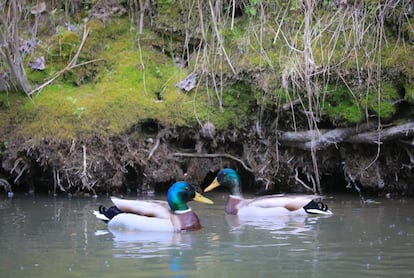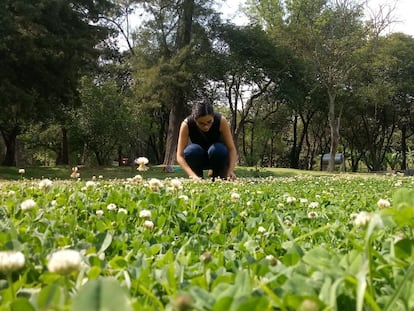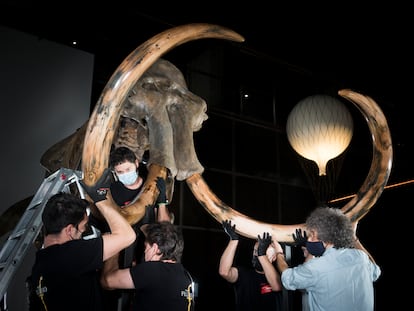How the book ‘Sex on Earth’ details a new Kama Sutra for animals
The text from British zoologist Jules Howard busted more than a few myths and clichés when it was published, reclaiming the essential role of females in evolution

[This article was originally published in Spanish in June 2015]
More than a century ago, in 1911, the polar explorer George Murray Levick couldn’t believe his eyes. He was trapped deep in Antarctica along with five other men. They were sheltering in an ice cave until springtime, when they hoped a boat would arrive to their rescue. For months, Levick passed his time observing penguins and taking meticulous notes about their behavior.
The explorer, who formed part of the Terra Nova expedition led by the British captain Robert Falcon Scott, couldn’t believe what he was seeing. The male Adélie penguins fornicated with other males, raped penguin chicks, forced themselves upon the females and rubbed themselves against the ground until they ejaculated. He once saw several of them penetrate females who had been dead for more than a year. Confused, Levick noted the practices in his notebook. So that his colleagues wouldn’t think he’d gone crazy, he documented the incidents in Greek.
British zoologist Jules Howard, who has published articles in The Guardian, The Independent and BBC Wildlife, among others, recalls the anecdote. In 2015, Howard made his scientific literature debut with the book Sex on Earth, whose subtitle is “a celebration of animal reproduction.”
With his book, Howard destroys the eternal debate among scientific researchers about how to make their work accessible to the general public. Anyone who can read will enjoy Sex on Earth. “Am I the only one who wonders how the Earth’s movement around the sun affects how horny the frogs in my pond might be? Why do we have sex? Why do sticklebacks have it? Why do some animals, like wasps, have sex and then largely die, and yet other animals carry on ready for more sex the year after?” the zoologist asks in his book.
The tome avoids common clichés about animal sex, such as the sexual cannibalism of the praying mantis and the huge member of the blue whale, offering instead a new animal kama sutra in light of Darwin’s theory of evolution. And, above all, Sex on Earth avoids being reduced to a bibliography obsessed with animals’ penises, and reclaims the essential role of females in evolution. “The world needs more stories about vaginas,” the author insists. One of his stories centers on ducks’ lower oviduct, a fleshy pink tube through which sperm circulates and eggs pass through. To avoid technicalities, Howard calls it a vagina. “Pedants be damned,” he writes.

Duck sex has had its 15 minutes of fame in recent years. In 2013, a controversy broke out in the United States after several media outlets broke down where the country’s funding of scientific research was going. A headline in the Christian Post read: “Feds spend $400,000 to study duck genitals.” Of those polled, 87% disapproved of their tax dollars going to fund the observation of birds’ reproductive systems, according to a Fox News poll. And the issue followed then-President Barack Obama for weeks.
For Howard, the hubbub demonstrated two things: that citizens don’t know how basic scientific investigation works, and that they’re not so far from the prudish times of Antarctic explorer Levick. Scientists who study sex no longer have to write their notes in Greek – but they still face a society easily scandalized by their research.
In his book, the British researcher recreates the protrusion of duck penises, made known on social media thanks to slow-motion videos by professor Patricia Brennan from the University of Massachusetts Amherst. The videos show how a duck’s erection occurs in less than a third of a second, at a velocity of 1.6 meters per second – as Howard notes, a similar speed to that of a confetti gun.
Stories about ducks’ genitals tend to focus only on males, whose protrusive sexual organs evolved to survive in a world where competition for females is vicious. But the British zoologist completes the puzzle. He discusses the long-overlooked vaginas of mallard ducks. “It is corkscrew shaped, much like the male’s anatomy, but here’s the thing: it spirals in the other direction, making it almost absurdly non-compatible with exploding duck penises. Not only this, it also has outpockets and dead ends. It really is like an Inca temple. It is ridiculous. A masterpiece. Evolutionary art,” Howard narrates.
Darwin began viewing females of some species as drivers of evolutionary change, not as prissy extras who stood around gawping at males in battle
Sex on Earth gives an explanation. Females have developed a mechanism that allows them to decide who fertilizes their eggs. One of every three of their copulations could be considered a rape, but only 3% of the eggs they lay are fertilized by their assailants. “The females have evolved this complex genitalia to block unwanted male advances,” the author points out.
The undesired males’ penises are unable to arrive at the end of the labyrinth, despite their speed of 1.6 meters per second. Their sperm gets lost in the vagina’s nooks and crannies. But when the duck so desires, she loosens the walls of her oviduct and gives a free pass to the future father of her children. Her criteria couldn’t be more Darwinian. According to some studies, female mallards choose partners based on the yellow of the males’ beaks, which is associated with a healthy immune system and the absence of illness. The ducks want to make sure that their genes are carried forward. The ducks’ genitals are, according to Howard’s analysis, “a sexual arms race between males and females.”
The British naturalist Charles Darwin published his book The Descent of Man, and Selection in Relation to Sex in 1871. In it, he toyed with the idea that females, by applying strict criteria, could encourage the evolution of certain features in males, such as elks’ extraordinary antlers, more an ornament than an attack weapon. “Darwin began viewing females of some species, particularly elks and peacocks, as drivers of evolutionary change, not as prissy extras who stood around gawping at males in battle. This was indeed revolutionary. It was a female power,” Howard proclaims.

The zoologist puts on the table conservation issues related to sex. He recalls a nocturnal visit, organized by The Wildlife Trusts, to the Cherry Hinton Chalk Pits close to Cambridge, England. There, expert David Seilly describes the apparently brutal impact of public lighting on glowworms. “The trouble is, the males probably go and mate with the streetlights rather than mate with the females,” Seilly explains. A species, Howard reflects, could go extinct because its males neglect their females to throw themselves against illuminated glass.
Sex on Earth also busts some common cultural myths. The zoologist recalls the case of the animated film Finding Nemo. The film begins with a clown fish couple, male and female, taking care of their eggs. Suddenly a barracuda devours the mother, and the father raises Nemo, the only egg that survives the attack. Howard breaks down the fictional story and creates a more lifelike narrative, based on what a male clown fish really does when his partner dies.
“The father, like many male reef fish, would have become a female. Sequential hermaphroditism. Being an only child, Nemo would have been born as an undifferentiated hermaphrodite, grown up as a male, and in a surprising twist, he would have end up having sex with his father, now a female,” the author relates. “But that’s not all. If the father died, Nemo would carried on the family legacy by becoming a female, to have sexual relations with his descendants if there weren’t any other clown fish around,” Howard explains.
The zoologist finishes off his book with an argument in favor of the science of sex and against society’s prudishness. “George Levick, the Antarctic explorer who was so fearful of the academic response to his observations about Adélie penguin sex, lived a century ago. Occasionally I have wondered how far we’ve come since then in our public understanding and discussion of such issues.”
Tu suscripción se está usando en otro dispositivo
¿Quieres añadir otro usuario a tu suscripción?
Si continúas leyendo en este dispositivo, no se podrá leer en el otro.
FlechaTu suscripción se está usando en otro dispositivo y solo puedes acceder a EL PAÍS desde un dispositivo a la vez.
Si quieres compartir tu cuenta, cambia tu suscripción a la modalidad Premium, así podrás añadir otro usuario. Cada uno accederá con su propia cuenta de email, lo que os permitirá personalizar vuestra experiencia en EL PAÍS.
¿Tienes una suscripción de empresa? Accede aquí para contratar más cuentas.
En el caso de no saber quién está usando tu cuenta, te recomendamos cambiar tu contraseña aquí.
Si decides continuar compartiendo tu cuenta, este mensaje se mostrará en tu dispositivo y en el de la otra persona que está usando tu cuenta de forma indefinida, afectando a tu experiencia de lectura. Puedes consultar aquí los términos y condiciones de la suscripción digital.
More information
Últimas noticias
The new victims of the Republican war on Obamacare: Millions hit by soaring health insurance premiums
A country divided on migrant rights: Some US states expand protections while others restrict them
Venezuela authorizes the release of another 87 political prisoners
There is as much life left to discover on planet Earth as that which is already known
Most viewed
- David King, chemist: ‘There are scientists studying how to cool the planet; nobody should stop these experiments from happening’
- Reinhard Genzel, Nobel laureate in physics: ‘One-minute videos will never give you the truth’
- Oona Chaplin: ‘I told James Cameron that I was living in a treehouse and starting a permaculture project with a friend’
- Sinaloa Cartel war is taking its toll on Los Chapitos
- The Interoceanic Train, the Mexican alternative to the Panama Canal











































